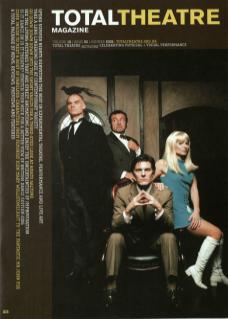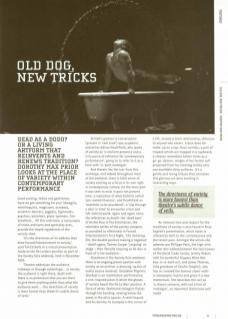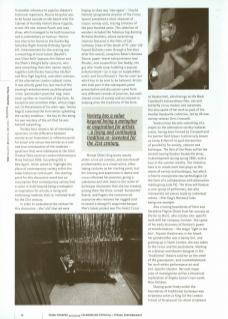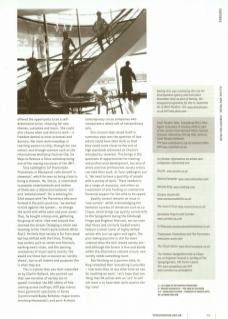Good evening, ladies and gentlemen, have we got something for you! Showgirls, ventriloquists, magicians, acrobats, eccentric dancers, jugglers, hypnotists, psychics, aerialists, plate-spinners, fire-breathers... All this and more, a cornucopia of tricks and turns and speciality acts, provide the staple ingredients of the variety show.
‘It's the directness of its address that drew Forced Entertainment to variety,’ said Tim Etchells in a virtual presentation made at the De La Warr pavilion as part of the Variety Acts weekend, held in November 2005.
‘Theatre addresses the audience sideways or through subterfuge... in variety the audience is right there, dealt with... there is no pretension that you are there to give them anything other than what the audience want... this directness of variety is more honest than theatre's subtle dance of veils.’
Etchell's partner in conversation (present in ‘real time') was academic and writer Adrian Heathfield, who spoke of variety as ‘a resilient presence and a rich source of reference for contemporary performance', going on to refer to it as a form with 'in-built nostalgia'.
And therein lies the rub: from this exchange, and indeed throughout most of the weekend, there is little sense of variety existing as a force in its own right in contemporary culture; for the most part it was seen to exist in past not present time, a repository of what Etchells called ‘pre-owned illusions', and Heathfield an 'aesthetic to be plundered', a 'slip through a door in time' to encounter a lost and left behind world. Again and again came the references to death: the ‘dead eyes' of Archie Rice in The Entertainer; the relentless smiles of the variety compere, as parodied so effectively in Forced Entertainment's First Night, ‘life imitating life, the double positive making a negative’ – death again; Tommy Cooper 'corpsing' on stage – then literally corpsing as he dies in front of a live audience...
Elsewhere in the Variety Acts weekend there is an ongoing preoccupation with variety as an archive: a dressing-up box of useful source material. Geraldine Pilgrim's Stardust is an installation-performance, a site-inspired piece in which the ghosts of variety haunt the De La Warr pavilion. A flock of white-feathered showgirls flutter through the building, nesting below the eaves in the attic spaces. A ventriloquist and his dummy lie slumped in the corner of a lift, locked in their relationship, oblivious to anyone who enters. A diva does her make-up on a top-floor corridor; a pair of trapeze artists are trapped in a cupboard; a cleaner remembers better times as a go-go-dancer, images of her former self projected from her cleaning trolley onto any available shiny surfaces. It's a gentle and loving tribute that animates this glorious art deco building in interesting ways.
An inherent love and respect for the traditions of variety is also found in Rose English's presentation, which takes in references both to the contemporary and the recent post. Amongst the artists she admires are Philippe Petit, the high-wire walker who walked between the twin towers of the World Trade Center; Jeremy Robins with his wonderful Slippery When Wet boy-in-a-bath act; and James Thiérrée (the grandson of Charlie Chaplin), who has recreated the famous clown-with-a-newspaper routine and given it a new momentum. She describes this act as 'a classic scenario, with not a hint of nostalgia', an important distinction well made.
In another reference to popular theatre's historical repertoire, Marcia Farquhar was to be found outside on the beach with The Cabinet of Horribly Violent Glove Puppets, a real-life one-woman Punch and Judy show, which managed to be both humorous and a commentary on humour. Marcia was also to be found on the Duckie Big Saturday Night Seaside Birthday Special bill. Entertainment for the evening was a mixed bag of local talent (Bexhill's own Silver Bells Soprano Ann Dalton and the Sheik's Delight belly-dancers, who were everything that their names imply), together with Duckie favourites Ida Barr and Miss High Leg Kick, and other veterans of the alternative London cabaret scene. It was all jolly good fun, but much of the evening's entertainment could be placed in the ‘postmodern pastiche' bag: more send-up than re-invention of the form. An exception was Jonathan Allen, whose magic act (in the persona of his alter-ego, Tommy Angel) subverted the form whilst upholding the variety tradition – the key to this being his own mastery of the art that he was himself subverting.
Variety Acts raised a lot of interesting questions on the difference between variety as an inspiration or reference point for visual arts versus new variety as a real and true continuation of the tradition – questions that were addressed at the Total Theatre Talks event at London International Mime Festival 2006: Everything Old is New Again, which aimed to 'highlight the place of contemporary variety within the wider historical continuum'. The starting point for this discussion event was an assumption that contemporary variety had a value in itself beyond being a metaphor or inspiration for artists; a living and continuing tradition that re-invented itself for the 21st century.
In order to understand the context for this discussion – the 'old' that we were hoping to show was 'new again' – Charlie Holland (programme director of The Circus Space) presented a short showreel of classic variety acts, tracing a history of the past hundred years. This selection of wonders included the fabulous tap dancing Nicholas Brothers, whose astonishing routines featured in the films of Cab Calloway (news of the death of 91 year-old Fayard Nicholas came through a few days after this event); Josephine Baker's Banana Dance; paper-tearer extraordinaire Joan Rhodes; new vaudevillian Tom Noddy, the guy who 'made soap-bubbling a popular entertainment' (as it says on soapbubbler.com); and Circo Roncali's 'live fur coat' act which has to be seen to be believed. Artists who took part in the subsequent panel presentation and discussion came from very different strands of practice, but each shared a love of variety and an interest in keeping alive the traditions of the form.
Miriam (Mim) King works mostly within a live art context, and sees herself predominantly as a visual artist, often taking costume as her starting point; but her training and experience in dance and circus informed her practice, giving a substance and skill-base to the roster of burlesque characters that she has created, among them the three-armed 'humanette’ Gracie, and Pugalo the contortionist scarecrow who removes her ragged coat to reveal a showgirl's sequinned basque. Mim's latest project was The Insect Circus at Hoxton Hall, which brings to life Mark Copeland's extraordinary flea, ant and butterfly circus models and automata. She also spoke of her work as part of the Voodoo Vaudeville collective, led by UK new variety veteran Chris Cresswell.
Voodoo have become something of a staple on the alternative variety/cabaret scene, having been formed by Cresswell and his partner Ruth Glaser (collectively known as Lenny & Morris) to push the barriers of possibility for variety, cabaret and burlesque. The Skin of the Moon will be the second touring Voodoo Vaudeville show, in development during spring 2006, with a tour in the summer months. The intention here is to create work that plays on the mores of variety and burlesque, but which is free to incorporate new technologies (in the form of a collaboration with alternative media group Junk TV). The show will feature a core-group of performers, but also incorporate set pieces made by individual artists – Mim King's Mermaid Tales being one example.
Also crossing boundaries of form was Geraldine Pilgrim (fresh from her success at the De La Warr), who creates site-specific work with her company Corridor. She spoke of her early discovery of theatre's power of transformation – the magic 'light in the box'. Popular theatre was in her blood: her grandmother was a Gaiety Girl, and growing up in South London, she was taken to the circus and the pantomime. Working as a dresser and theatre designer in the 'traditional’ theatre sold her on the smell of the greasepaint, and counterbalanced her work within performance art and site-specific theatre. Her next major area of investigation will be a theatrical exploration of Angela Carter's last novel, Wise Children.
Staying quite firmly within the boundaries of traditional burlesque was striptease artist Jo King (of the London School of Striptease) for whom striptease offered the opportunity to be a self-determined artist, choosing her own themes, costumes and music. She could also choose when and where to work – a freedom denied to most actresses and dancers. Her main work nowadays is teaching women to strip, through her own school, and through avenues such as the International Workshop Festival (her Six Ways to Remove a Glove workshop being one of the roaring successes of the IWF).
Tony Lyddington (of Promenade Promotions in Blackpool) calls himself a ‘showman', which he sees as being close to being a shaman. He, like Jo, is committed to popular entertainment and neither of them sees a distinction between 'art’ and 'entertainment'. He is entering his 23rd season with The Pierrotters who were formed in the post-punk era: 'we wanted to kick against the system... to change the world with white satin and pom-poms.' Thus, he bought a banjo and, gathering his group of satin-clad men around him, stormed the streets (bringing a whole new meaning to the Clash's punk anthem White Riot). He feels that variety is far from dead but has shifted with the times, finding new outlets such as street arts festivals, working men's clubs, and the opening ceremonies of major sports events; few would see these last occasions as 'variety shows', but to all intents and purposes this is what they are.
This is a point that was later expanded on by Charlie Holland, who pointed out that new varieties of variety (so to speak) included: the BBC idents of freerunning across rooftops; MTV pop videos; mass gymnastic spectacles in Korea (synchronised Busby Berkeley-esque events involving thousands); and post-Archaos contemporary circus companies who incorporate a whole raft of extraordinary acts.
One concern that raised itself in numerous ways was the question of how artists could hone their skills so that they could come closer to the sort of high standards witnessed on Charlie's introductory showreel. This brings in the questions of opportunities for training and professional development, but also of where and how professional variety artists can take their work. As Tony Lyddington put it, 'We need to have a quantity of people with a variety of skills.' There needed to be a range of resources, and either an investment of arts funding or commercial financial support for the ante to be upped.
Quality control remains an issue in 'new variety': whilst acknowledging the fantastic success of initiatives such as La Clique, which brings top quality variety bills to the Spiegeltent during the Edinburgh Fringe and Brighton festivals, we can note that these and similarly lauded events feature a small roster of highly skilled artists who turn up again and again. The piss-taking pastiche is still far more common than the skill-based variety act – and although the former is fine and dandy within the alternative cabaret circuit, new variety needs something more.
But finishing on a positive note, Jo King remarked that ‘everything is possible – now more than at any other time we can do anything we want'. Let's hope that one thing that UK artists with an 'act' to sell will want is to hone their skills and hit the big-time!
Variety Acts was curated by the Live Art Development Agency and took place November 2005 as part of Variety, the inaugural programme for the re-launched De La Warr Pavilion. See www.thisisliveart.co.uk and www.dlwp.com
Total Theatre Talks: Everything Old is New Again took place in January 2006 as part of the London International Mime Festival, and was chaired by Felicity Hall, director, Total Theatre Network. See www.totaltheatre.org.uk/projects/talks and www.mimefest.co.uk
The Famous Spiegeltent and La Clique are at Brighton Festival 5-29 May in The Spiegelgarden, Old Steine Lawns. See www.spiegeltent.net and www.komedia.co.uk/brighton



